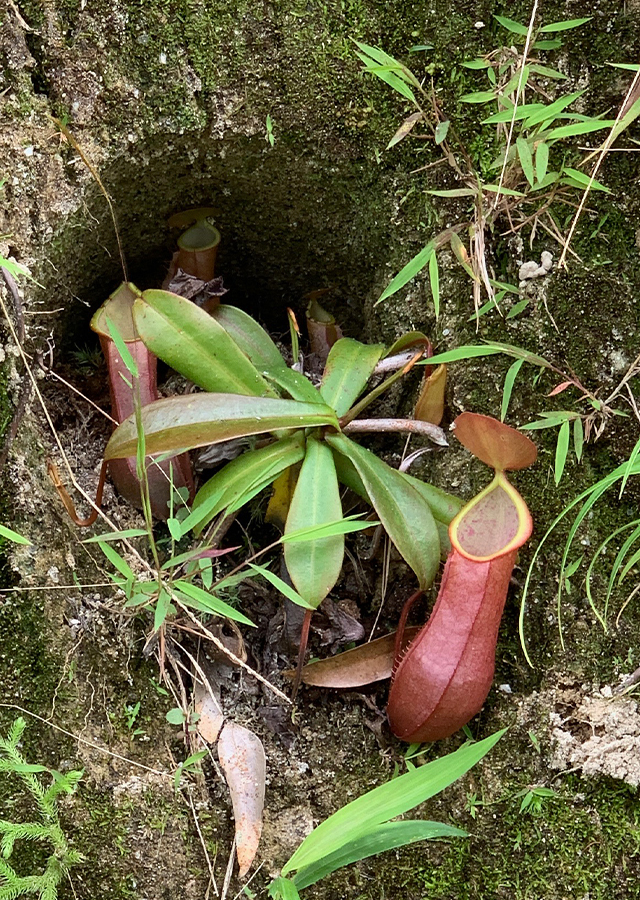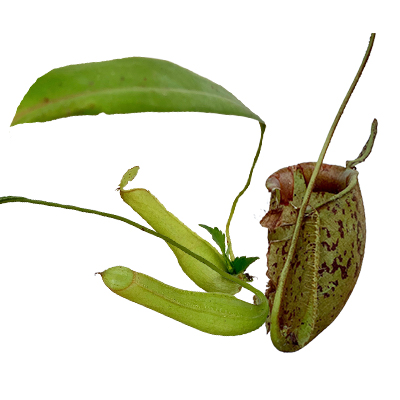Tropical Pitcher Plant
Nepenthes gracilis Korth.
Nepenthaceae
Location in our garden
Green House



Synonym
Nepenthes angustifolia Mast.
Nepenthes korthalsiana Miq.
Nepenthes laevis Lindl.
Habitus
Climbers. Dioecious, perennial, woody or subwoody climbers or subshrubs, terrestrial or epiphytic.
Part Used
The Whole Plant
Growing Requirements
Full Sunshine
Need Shade
High Rainfall
Habitat
Forest
Rocky Areas
Overview
Nepenthes origin is suspected in the area of the western Indian Ocean and includes about 87 species, mostly in Malesia (Malaysia, Singapore, Brunei, Indonesia, Philippines, Papua New Guinea), with the majority of species found in Borneo and Sumatra. The stems of many species are used as rough cordage, although the main use of Nepenthes is as an ornamental. Nepenthes gracilis is native Brunei Darussalam, Indonesia (Sumatera, Kalimantan, Sulawesi). Malaysia (Sabah, Sarawak, Peninsular Malaysia), Singapore, Thailand.
Vernacular Names
Kantong semar
Agroecology
Nepenthes are found in tropical climates, especially in nutrient-poor soils in exposed ecosystems. It is commonly found in wet mossy woodland, along river banks and ridge tops. It typically grows in areas with a thin or sparse canopy and is not common in dense forests. It is prevalent in white podsolic, wet peaty or heavily leached volcanic soils, but almost entirely absent from rich alluvial or artificial soils. In montane habitats, at 1,500-2,500 m altitude, more species but fewer individuals occur, mostly in open mossy, stunted, ridge-top forest. In montane or subalpine grasslands, up to an altitude of 3,500 m, a few species are found. Nepenthes gracilis has upper elevation limit 1,200 metres. This species belongs terrestrial, with habitat type Artificial/aquatic and marine, artificial/terrestrial, wetlands (inland), shrubland, rocky areas (eg. inland cliffs, mountain peaks).
Morphology
- Stems - terete, 2-4-angled or more or less winged as an effect of decurrent leaves.
- Leaves - alternate, without stipules, petiolate or sessile, simple, papery or leathery, composed of a phyllodium-like blade, a tendril, a pitcher and a lid.
- Flowers - male flowers with 4-12 stamens, filaments united into a column (androphore), gynoecium lacking; female flowers without androecium, ovary superior, 4-locular with numerous ovules, stigmas 4, sessile
- Fruit - a fusiform, loculicidally dehiscent capsule with 4 valves
- Seed - filiform, 3-25 mm long, with long basal and apical appendages.
Cultivation
- Generative propagation occurs by seeds, typically germinating 4-6 weeks after seeding
- Vegetative propagation is through cuttings only a new stalk develops from a growth bud just above the leaf axis, so a leaf node or a developing tip must be included in all cuttings
Chemical Constituents
Flavonoids, terpenoids, tannins, alkaloids, steroids, and naphthoquinones.
Traditional Medicinal Uses
- Important in vitro antioxidant (peroxyl radicalscavenging and reducing effects) and antiosteoporotic (pre-osteoclastic RAW 264.7 cells) activities were shown by the methanolic extract of Nepenthes mirabilis (Nepenthaceae).
- In its pitcher fluid, Nepenthes distillatoria generates enzymes called nepenthesin I & II and the enzymes are active at a low pH of 2.3. These digestive enzymes, since they are - similar to pepsin, are useful for medical research. The ultimate aim of future research is to use these enzymes in research to avoid any effects of AIDS in people infected with HIV.
- Used in the treatment of leprosy, cholera, gastrointestinal distress, night blindness, dysentery, stomach pain, and bed-wetting.
- Water from unopened pitchers N. Korth Boschiana. as treatment for eye-inflammation has been considered (Borneo).
- Stems and roots are chewed against toothache by N. alata Blanco (Philippines).
- In Peninsular Malaysia, the boiled roots of N. gracilis are taken against dysentery and stomach ache, while extracts are taken in the Lingga Archipelago (Indonesia) in case of a sore mouth and swollen tongue
- Water is drunk from the pitchers of N. gynamphora Nees against cough in Java.
Part Used
Reference Sources
- Astuti, I.P., Kalsom, Y.U., and Taha, R.M. (2016). Nepenthes L. https://uses.plantnet-project.org/en/Nepenthes_L._(PROSEA). 09-03-2021.
- Fern, Ken. (2014). Useful Tropical Plants: Nepenthes reinwardtiana. http://tropical.theferns.info/viewtropical.php?id=Nepenthes+reinwardtiana. 09-03-2021.
- Nguyen, V.T., Nguyen, P.T.,Phan T.T.H.,Sang, H.L.,Hae, D.J., Nguyen, X.C., Nguyen, H.N.,Phan, V.K.; Young, H.K.; Chau, V.M. (2015). Naphthoquinone and flavonoid constituents from the carnivorous plant Nepenthes mirabilis and their anti-osteoporotic and antioxidant activities. Phytochemistry Letters Vol. 11.pp.254-259. https://doi.org/10.1016/j.phytol.2015.01.009. 31-08-2020.
- Sanusi, S.B., Abu Bakar, M.F.,Mohamed, M., Sabran, S.F.;, Mainasara, S.M.(2017). Ethnobotanical, phytochemical, and pharmacological properties of Nepenthes species: A review. Asian Journal of Pharmaceutical and Clinical Research 10(11):16-19. DOI: 10.22159/ajpcr.2017.v10i11.20050. 31-08-2020.
- IUCN Redlist. (2021). Nepenthes gracilis. https://www.iucnredlist.org/species/39663/143960417. 21-12-2021.

